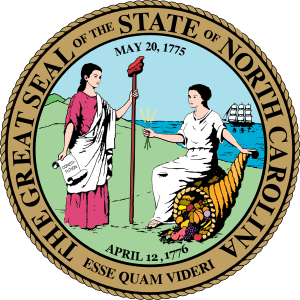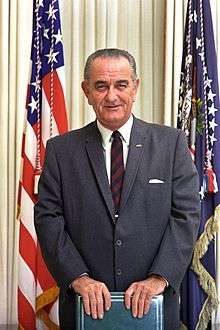Luther H. Hodges
Luther Hartwell Hodges (March 9, 1898 – October 6, 1974) was a businessman and American politician. After a career in textile manufacturing, he entered public service, gaining some state appointments. Elected as lieutenant governor of North Carolina in 1952, he succeeded to the Governor's office in 1954 after the death of the incumbent. He was elected in 1956 to a full four-year term, serving in total as the 64th Governor of the state of North Carolina from 1954 to 1961.
Luther Hodges | |
|---|---|
 | |
| 15th United States Secretary of Commerce | |
| In office January 21, 1961 – January 15, 1965 | |
| President | John F. Kennedy Lyndon B. Johnson |
| Preceded by | Frederick H. Mueller |
| Succeeded by | John T. Connor |
| 64th Governor of North Carolina | |
| In office November 7, 1954 – January 5, 1961 | |
| Lieutenant | Luther E. Barnhardt |
| Preceded by | William B. Umstead |
| Succeeded by | Terry Sanford |
| 22nd Lieutenant Governor of North Carolina | |
| In office January 8, 1953 – November 7, 1954 | |
| Governor | William B. Umstead |
| Preceded by | Hoyt Patrick Taylor |
| Succeeded by | Luther E. Barnhardt |
| Personal details | |
| Born | Luther Hartwell Hodges March 9, 1898 Cascade, Virginia, U.S. |
| Died | October 6, 1974 (aged 76) Chapel Hill, North Carolina, U.S. |
| Political party | Democratic |
| Spouse(s) | Martha Blakeney
( m. 1922; died 1969)Louise Finlayson
( m. 1970; |
| Children | 3 |
| Education | University of North Carolina, Chapel Hill (BA) |
| Military service | |
| Allegiance | |
| Branch/service | |
| Battles/wars | World War I |
In 1961 he was appointed as United States Secretary of Commerce under President John F. Kennedy, serving until 1965.[1] He returned to North Carolina and served as chairman of Research Triangle Park, a major facility established during his tenure as governor.
Hodges is also remembered as a racist, resisting integration of schools during the Civil Rights Movement and facilitating the brutal treatment and conviction of two african-american children for rape during the Kissing Case.
Biography
Hodges was born in Cascade,[2] Pittsylvania County, Virginia, on March 9, 1898. At the age of two, he moved with his family to Spray (which later merged with two other towns to become Eden, North Carolina). After growing up there, he lived much of his life in Rockingham County, North Carolina.
Hodges left for the University of North Carolina at Chapel Hill at age 17, where he was a member of the Dialectic and Philanthropic Societies, and moved back to Eden after graduation. He went to work at Carolina Cotton and Woolen Mills in Leaksville. In 1923, he helped form the Leaksville Rotary Club, which later became known as the Eden Rotary.
Carolina Cotton was later purchased by Marshall Field. Hodges continued to work for the company, working his way up from millworker to executive positions, until he retired to enter politics. In the 1940s, he gained gubernatorial appointments to the state Board of Education and the Highway and Public Works Commission. In 1945, he served as a consultant to the U.S. Secretary of Agriculture and to the U.S. Army in occupied Germany.
Hodges ran for office as lieutenant governor in 1952 and was elected. He succeeded to the position of governor in November 1954 upon the death of Governor William B. Umstead in office.
Two years later, Hodges was elected on his own account to a full four-year term as governor. Because North Carolina had a one-term limit for governors at that time, Hodges had the longest continuous tenure in the office until the state constitution was changed and Jim Hunt was elected to a second term in 1980.
During his time in office, Governor Hodges promoted industrialization and education.[3] He helped gain support for the establishment of Research Triangle Park, intended to attract innovation and industry to the North Carolina Piedmont, and to strengthen connections among the three universities involved. After Hodges completed his tenure in 1965 as Secretary of the Department of Commerce, he returned to Chapel Hill. He was appointed as Chairman of Research Triangle Park. In 1967, he served a one-year term as president of Rotary International.
Civil rights
In 1959, Hodges became involved in the Kissing Case, where two young African-American boys (one aged 9, and one aged 7) had been convicted of rape because a white girl (aged 8) had kissed them each on the cheek. They had been sentenced to the state reformatory. A range of activists, civil rights organizations, Eleanor Roosevelt and President Eisenhower, in addition to the international press, pressured Hodges for clemency. After three months Hodges pardoned them, but refused to apologize.[4]:118 [5] Former First Lady Eleanor Roosevelt "led an international campaign on their behalf."[4]:118[6]:118
Later years
He died on October 6, 1974, in Chapel Hill, North Carolina, and is buried at the Overlook Cemetery in Eden, North Carolina. A monument was erected in his honor near a water fountain in Eden's Freedom Park.
Legacy
Hodges's son, Luther H. Hodges Jr., was a prominent banking executive and United States Deputy Secretary of Commerce.
References
- Lawrence Kestenbaum, ed. (nd), "Hodges, Luther Hartwell (1898-1974) — also known as Luther H. Hodges", Political Graveyard, retrieved January 19, 2017
- NNDB
- "Gallery of past presidents". Rotary International. Archived from the original on 22 January 2012. Retrieved 22 December 2011.
- Allida M. Black (1996), Casting Her Own Shadow: Eleanor Roosevelt and the Shaping of Postwar Liberalism, Columbia University Press, retrieved January 19, 2017 Missing or empty
|title=(help);|chapter=ignored (help) - Sue Sturgis (April 25, 2014), "Remembering Southern Black freedom fighter Mabel Williams", Facing South, Institute of Southern Studies, retrieved January 19, 2017
- Allida M. Black (1996). Casting Her Own Shadow: Eleanor Roosevelt and the Shaping of Postwar Liberalism. Columbia University Press. ISBN 978-0231104050.
| Political offices | ||
|---|---|---|
| Preceded by Hoyt Patrick Taylor |
Lieutenant Governor of North Carolina 1953–1954 |
Succeeded by Luther E. Barnhardt |
| Preceded by William B. Umstead |
Governor of North Carolina 1954–1961 |
Succeeded by Terry Sanford |
| Preceded by Frederick H. Mueller |
United States Secretary of Commerce 1961–1965 |
Succeeded by John T. Connor |
| Party political offices | ||
| Preceded by William B. Umstead |
Democratic nominee for Governor of North Carolina 1956 |
Succeeded by Terry Sanford |
| Non-profit organization positions | ||
| Preceded by Richard L. Evans |
President of Rotary International 1967–1968 |
Succeeded by Kiyoshi Togasaki |



